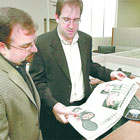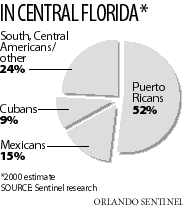|
 |
|
Esta página no está disponible en español. Tribune Publishing Launching Spanish-Language Daily In Chicago…El Nuevo Día Targets Hispanics In Orlando
Tribune Publishing Launching Spanish-Language Daily In Chicago By Mary Aviles August 15, 2003 Chicago, Aug 11 (EFE).-The Tribune Publishing group, noting the Windy City's burgeoning Hispanic population, is preparing to transform its 10-year-old Spanish-language weekly, Exito, into the daily Hoy. "The Hispanic population in Chicago is nearly two million people strong and it was evident that it needed a daily like Hoy to better serve the community," Louis Sito, vice president of Tribune Publishing's Hispanic media department and president, publisher and CEO of Hoy, told EFE. "We are going to transfer the vision we have in Hoy of New York, but with a strong focus on local content. That's the most important thing, that it have strong roots in the community," said the Cuban-born Sito. Hoy will hit the streets in early September and be sold throughout Chicago for 25 cents an issue. The new publication will focus on local issues, but it will also offer daily segments on news from Mexico, Puerto Rico, Central America, South America and the Caribbean. On Fridays, readers will be able to keep abreast of the latest trends in music, food, movies and local events in Vida Hoy, a weekend supplement specializing in Hispanic cultural happenings. According to the 2000 census, Hispanics represent 19 percent of the population of Cook County, while "Chicago represents the fourth-largest Hispanic market in the United States, being larger than most of those in the leading cities," said Sito. Hoy made its debut in New York in November 1998, and in less than five years it has become the second-most read Spanish-language daily in the nation. "In March, we surpassed El Nuevo Herald's circulation," said Sito - who became head of Tribune Publishing's Hispanic media department in February - referring to Miami's leading Spanish-language daily. Hoy currently boasts a circulation of more than 91,000 during the week and sells nearly 32,000 issues of its Sunday edition. The only Spanish-language daily with a greater circulation is the Los Angeles-based La Opinion. Hoy belongs to, and La Opinion is 50 percent owned by the Chicago-based Tribune Company, one of the country's largest publishing groups, which also owns the Los Angeles Times, Chicago Tribune and Newsday, as well numerous radio and television stations. The Lozano family publishes the Spanish-language newspaper La Opinion in Los Angeles. The Tribune Company publishes Exito in Chicago, Hoy in New York and El Sentinel in Florida. But the new Hoy is not just the answer to a call by Hispanics for a Spanish-language daily, it also marks an important demographic change in Chicago and the rest of the United States. "Under my tutelage, we expect to find the best way to reach the Hispanic markets where we have a presence," said Sito.
El Nuevo Día Targets Hispanics Spanish-Language Daily Jumps Into Growing Orlando-Area Media Market By Christopher Boyd | Sentinel Staff Writer August 24, 2003
FAST FACTS: El Nuevo Día Publisher: Grupo Ferré Rangel Headquarters: San Juan, P.R. Related publications: El Nuevo Día and Primera Hora in Puerto Rico Significant fact: El Nuevo Día in Orlando will be the company's first publication outside Puerto Rico. A new Spanish-language daily newspaper will soon join a media stampede catering to Central Florida's exploding Hispanic population. The paper, El Nuevo Día, hopes to find an audience in the Orlando area's increasingly diverse Hispanic community, offering a mixture of local and international news augmented by reports from Puerto Rico's El Nuevo Día, the publication's namesake and the island's largest and most influential daily newspaper. ---------- El Nuevo Día -- which means "The New Day" -- is the latest entrant in a rapidly growing field of Central Florida Spanish-language media. The region has AM and FM radio stations, as well as several television stations, that broadcast in Spanish. Two years ago, Orlando Sentinel Communications launched a free weekly newspaper, El Sentinel, which contains stories in both Spanish and English. "We have been studying the market here for several years, and the projections for growth are very positive," said Jaime Segura, the new paper's general manager. "We will be trying to reach the whole Hispanic community in Central Florida with a complete newspaper that covers everything from A to Z." Segura said El Nuevo Día would debut with a press run of about 25,000 papers. The paper, a Monday-through-Friday tabloid that will cost 50 cents, will be distributed at grocery and convenience stores, pharmacies, neighborhood bodegas and a variety of other retail outlets. Segura said he expects to publish the first issue on Sept. 2. The paper's focus will be local, offering reports from Orange, Seminole, Osceola, Lake and Volusia counties in Spanish, accompanied by news summaries in English. Initially, the paper will have a staff of 40, including 13 in the editorial department. "Our editorial content won't be aimed at Puerto Ricans," said José Maldonado, the paper's editor. "You have Mexicans, Colombians and many other nationalities in Central Florida. We will have sections on Latin America, Florida and national news." The paper is owned by Grupo Ferré Rangel, which also owns Puerto Rico's El Nuevo Día. Maldonado said the Orlando paper would average about 48 pages and would include information not commonly included in English-language dailies. "There will be sports from the various Latin American countries," he said. "We know our community and what it wants." El Nuevo Día will also include a feature section, called Vida en Orlando, that will profile people making significant contributions to the local community, Maldonado said, and it will cover social events that are particularly relevant to Hispanic readers. The surge in Spanish-language media reflects the huge growth of the region's Hispanic population. During the 1990s, Central Florida's Hispanic population grew to more than 320,000 -- a 152 percent increase. And the pace continues. Aly Colon, director of the diversity program with Poynter Institute, a journalism-education center in St. Petersburg, said the arrival of a Spanish-language daily in Central Florida fits a national trend. "One of the fastest-growing areas of the newspaper business is what you might label the ethnic news media sector, and the Hispanic or Latino market stands out in this area," Colon said. "There is a public hunger among a lot of different groups, especially those moving into communities that are unfamiliar to them. There is a demand for publications that serve as a bridge between the new place and the culture that the people are familiar with." Marcelo Ballve, an associate editor who covers the Hispanic media for Pacific News Service in San Francisco, said the still-small Hispanic media market has big growth potential. "This is something that is happening in all the major Hispanic cities in the country," Ballve said. "Although the Hispanic market in Orlando isn't huge right now, the Puerto Rican market in Orlando is one of the fastest growing in the country. That makes it attractive." Nationwide trend Spanish-language newspapers and broadcasters are expanding nationwide. Next month, for example, Tribune Co., parent of the Orlando Sentinel, plans to replace its Chicago-area Spanish-language weekly, Exito, with a daily newspaper, Hoy. Hoy debuted in New York in November 1998. Belo Co., the parent of the Dallas Morning News, plans to launch a six-day-a-week Spanish-language paper in Dallas in October. The 2000 census reported 162,000 Puerto Ricans living in Central Florida -- 182 percent more than in 1990. The surging population means more consumer spending, something that media organizations can use to lure advertisers. The market has an assortment of Spanish-language radio stations and television stations broadcasting programming from the Univision, Telemundo and Azteca America networks. Hispanic population growth has driven the growth of broadcast, which captures the lion's share of spending nationwide on advertising aimed at Hispanics. Advertising is the major source of newspaper revenue, and the growing competition for Spanish-language advertising dollars in Central Florida is certain to intensify with El Nuevo Día's arrival. Population boom Aida Levitan, co-chairman of the Publicis Sanchez & Levitan ad agency in Miami and president of the Association of Hispanic Advertising Agencies, said corporate advertising budgets haven't caught up with the Hispanic population, which has grown to 38 million. "Advertisers are spending 3.2 percent of their total budget on Hispanic advertising," Levitan said. "An AHAA study suggests that they should be spending about 8 percent of their budgets on Hispanic advertising." Levitan said that the increase in Spanish-language media, paired with rapid Hispanic population growth, should draw more advertising spending. She said Hispanic retail spending in the Orlando market reached $2.4 billion in 2002. "I believe Orlando is a wonderful opportunity for El Nuevo Día and for advertisers who want to reach Hispanics in that market," she said. Even though many Hispanics are fluent in English, Levitan said that they turn to Spanish-language media to connect with their culture. "The people who will be reached by El Nuevo Día are being reached through the language of the heart," she said, adding that advertisers can form a connection with Hispanics through Spanish-language media. "The print media that isn't addressing the Hispanic market is missing out on an important opportunity," Levitan said. Competition Irma Yapor, president of the Yapor advertising agency in Orlando, agreed that the Central Florida market is big enough to support a Spanish-language daily -- particularly one with such a high-profile name. "I believe that they will do very well considering that the majority of the Hispanic population here is from Puerto Rico," she said. "This is an emerging market, and the Hispanic population is booming. I absolutely think there is enough advertising here." Yapor said that non-Hispanic businesses probably would be interested in advertising in the publication as well. The desire to reach the Spanish-speaking and bilingual population was a key factor in the Orlando Sentinel's decision to launch El Sentinel in 2001. Anibal Torres, El Sentinel's publisher, said the broad mix of the Hispanic media makes Orlando a challenging market. "There are a lot of people going after the media dollars," Torres said. "But Orlando's prominence on the national scene is growing." Torres said he doesn't anticipate any change in El Sentinel's strategy in response to the arrival of El Nuevo Día. El Sentinel started in 2001 with an editorial staff of four, which grew to six last year. This year it added a seventh. Dora Casanova, editor of La Prensa, a Spanish-language weekly published in Longwood, said she expects negligible impact from the new newspaper. "My publication is a free publication, so I see no threat," Casanova said. "We are a weekly, which makes us different. So we welcome the competition." Market may grow El Nuevo Día's Segura said his publication will launch with "a couple" of national advertisements and that contracts for other high-profile ads are likely. Antonio Guernica, general manager of WVEN-Channel 26, the Orlando Univision network station, predicts the arrival of a Spanish-language daily in the region will raise the market's profile among advertisers -- benefiting the bottom line of publishers and broadcasters alike. "We are all competitors in a way. In another way, we are trying to bring attention to the Hispanic market," Guernica said. "I hope that advertisers in Puerto Rico will see the opportunities that the Orlando market offers." Segura said he thinks his publication should bring advertising to Orlando that will benefit the entire media market. "The market is ready for this in terms of income and size," Segura said. "It will be a win-win situation for everyone involved."
|

 ----------
----------